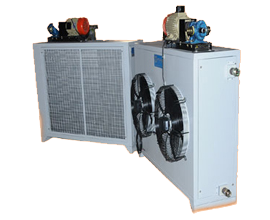Air Blast Oil Coolers

Advanced engineered Air blast coolers
An air blast chiller uses outside air to chill process fluids (such as lubricants). It is an expanded heat exchanger, often known as a tail fan cooler.
Our air blast chiller constitutes part of our industrial cooling product line. We manufacture coolers ranging from small devices for ship stabilizers to units over 6 meters in length and weighing multiple tons for extreme voltage directly current (HVDC) installations.
How Air Blast Coolers Work
Overview
Air blast chiller are utilized for process cooling. Ambient air is pumped across an exchanger of heat to remove heat from an enclosed system carrying process fluids or transitional coolant. Coolant returns temperatures may fall as low as 10 °C above the surrounding air.
Design Considerations
The header is the section of the cooler where coolant enters into the heat exchanging tubes. Depending on the use, design pressure, and requirements, the header might be tubular, rectangle with covered plates, or plugged.
The cooling fluid may pass numerous times along the cooler’s length in a crossover or counterflow configuration. The number of rounds depends on the placements of each of the baffles inside the headers. The optimal design is determined by the temperature differences and total flow rates of the tube and ambient streams.
Chillmax Technology created and produced an air blast chiller in front of their plant. Fans drive the airflow within the heat exchanger, after which the device is named. These can function in forced as well as induced draft conditions and are driven by electric or, on occasion, hydraulic motors. For the majority of applications, the motors are utilized in direct drive mode, however we may provide belt-mounted options.
Chillmax technology works with you to develop and construct the best air blast cooler for your needs. We review the key issues for your use and verify that your air blasting cooler is appropriate for the task.
Contact us today
Benefits
Air blast coolers can operate in a closed-circuit configuration, which is far superior than a conventional cooling tower. A closed-circuit system prevents direct contact among air and water, resulting in a cleaner cooling structure that is less susceptible to contamination and corrosion.
With this dependable technology, we can cut operational expenses and eliminate downtime.
Why pick Chillmax Technology air blast coolers?
Tough and dependable
We develop and produce air blast cooler with tube-to-tubeplate assembly using roller expansions or seal welding. As a consequence, our coolers provide great dependability and availability.
Flexible
We may pick from a variety of fin kinds and tube materials, including titanium as well as duplex steel. We can put it vertically or horizontally depending on your site requirements. We are employing plate-fin matrices that we can create modular units to satisfy any of your cooling needs.
Save money and reduce trash
Chillmax Technology built and constructed an air blast cooler in its plant. To achieve minimal power consumption and quiet operation, we carefully pick air conditioning fans and install them with louvered as well as flat fins. The ensuing closed-circuit systems are both ecologically friendly and cost-effective over open systems that use evaporative technology.
Our plenum chambers are designed to provide optimal air distribution across the surface that transfers heat while avoiding air recirculation as well as leakage.
Optimized noise level
The key factor influencing the equipment’s noise level is the fan’s rotational speed. Noise is an important concern in all designs. Our comprehensive design guarantees that the final operating noise levels exceed contract specifications.
A wide spectrum of materials
We provide a variety of tube as well as fin materials based on the coolant’s characteristics and the atmosphere’s corrosion potential.
Your Heat Exchange system Partner
As a reputable cooler manufacturer, we develop and manufacture air blast cooler for most industries, including chemical in nature, power generation, defense, gas and oil, food and beverage, and marine.
